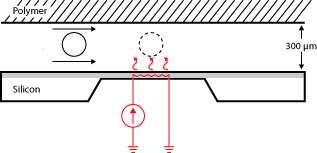Heat-based technique offers new way to measure microscopic particles

Researchers have developed a new heat-based technique for counting and measuring the size of microscopic particles. The technique is less expensive than light-based techniques and can be used on a wider array of materials than electricity-based techniques. The research was performed by faculty at North Carolina State University, the University of North Carolina at Chapel Hill and Marquette University.
"We launched this study purely out of curiosity, but it's developed into a technique that has significant advantages over existing methods for counting and measuring the size of microscopic objects," says Dr. Glenn Walker, senior author of a paper on the work and an associate professor in the joint biomedical engineering program at NC State and UNC-Chapel Hill.
Particle counters are used in a wide variety of industries. For example, physicians use them to count and identify blood and cancer cells while ink manufacturers use them to ensure consistent toner quality. The new thermal technique could also lead to new applications.
The researchers built a device in which an extremely narrow plastic tube rests on a silicon substrate. A wire is connected to a single point beneath the tube. An extremely small current is run through the wire, both generating heat that radiates into the tube and measuring the temperature of the tube and its contents.
When a solution containing microscopic particles is injected into the tube it flows past the wire and the heated area. When the particles pass through this thermal zone they alter the electrical resistance of the wire. This is because the thermal conductivity of a particle will either increase or decrease the temperature in that part of the tube, causing the electrical resistance to go up or down.
Since the researchers know the flow rate of the solution through the tube, they can measure the length of time that the electrical resistance was changed and calculate the size of the objects suspended in the solution.
"So far, we've tested this method effectively with objects in the 200 micron to 90 micron range – at the larger end of the spectrum commonly measured by commercial particle counters," Walker says. "But in theory we'll be able to get down to the 10 micron range and measure individual cells. We're working on that now."
The researchers are also exploring ways to use the technique to detect unwelcome metal particles resulting from machine wear in mechanical devices.
"There are three advantages to our technique," Walker says. "It's simple, it's inexpensive, and it can monitor any kind of particle. Flow cytometry – which uses light – is both expensive and complex, while Coulter counters – which use electricity – only work on objects that don't conduct electricity but are suspended in a solution that is conductive."
More information: The paper, "A Microfluidic Device for Thermal Particle Detection," was published online March 11 in Microfluidics and Nanofluidics: link.springer.com/article/10.1 … 07/s10404-014-1369-z
Abstract: We demonstrate the use of heat to count microscopic particles. A Thermal Particle Detector (TPD) was fabricated by combining a 500 nm thick silicon nitride membrane containing a thin-film resistive temperature detector (RTD) with a silicone elastomer microchannel. Particles with diameters of 90 [micrometers] and 200 [micrometers] created relative temperature changes of 0.11 K and -0.44 K, respectively, as they flowed by the sensor. A first-order lumped thermal model was developed to predict the temperature changes. Multiple particles were counted in series to demonstrate the utility of the TPD as a particle counter.
Provided by North Carolina State University




















